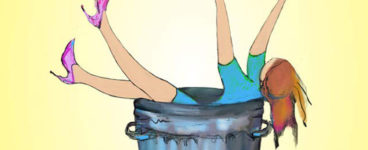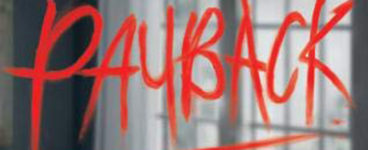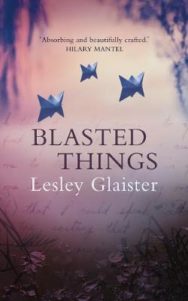‘if you want war, peace, dark secrets and edgy characters you can believe in, Lesley Glaister is in it for the long haul.’
If you’re looking for a writer whose skill in taking readers to a different time and place with characters that linger long in the mind, then David Robinson discovers that Lesley Glaister might just be the person you’re looking for, and that her new novel, Blasted Things, deserves to be added onto everyone’s bookshelves.
Blasted Things
By Lesley Glaister
Published by Sandstone Press
Daphne du Maurier, Kate Atkinson, Ruth Rendell, Gillian Flynn, Patricia Highsmith: read Lesley Glaister’s reviews and she’s been compared to all of them. The underlying thought is invariably the same – Glaister’s novels are every bit as good at chiselling out hidden secrets from expertly drawn characters, the psychological tension is equally taut, the writing just as dextrous. So how come she isn’t as well-known as they are?
Her sixteenth novel, Blasted Things, published this month by Sandstone Press, does nothing to make that question go away. There aren’t many novelists who can turn both their characters and plot inside out and still make both believable, but this novel, set in the immediate aftermath of the First World War, manages to do just that.
Unlike all of her other ones, it is rooted entirely in the past. The Walter Scott Prize for historical fiction defines it as being anything set more than sixty years in the past. As Blasted Things is set a full century ago, I suggest to Glaister that she has just gone and written her first historical novel. At the other end of the phone, I can hear her demurring, and I know why. Because although the book’s historical setting is well drawn (it opens in a First World War field hospital, before switching back to England in the first years of peace) and the period setting and social attitudes accurately conveyed, that’s not really its point.
‘Maybe that’s the problem with my work,’ she says. ‘It doesn’t really fit into any genre. Is it historical? Is it a romance? Is it a psychological thriller?’ Her own preferred form of words is ‘literary fiction with a nod to the dark side’. Which is fine, although I’d precede it with ‘character-driven’, because the two main protagonists of Blasted Things are so well drawn that they will hang around for a long while in the reader’s mind.
Clementine, a middle-class English girl, has returned from working as a nurse in a field hospital, where love briefly blossomed amid the horrors of war, to an unhappy marriage with a stolid Suffolk GP. There is, at least, stability to her life, although not in her mind, as nothing and no-one can match the intensity of her love for her wartime sweetheart. To Vincent, a lower-middle class war hero back in Blighty minus half of his face, peace brings the very opposite of stability. Instead, he has to hustle for survival: no-one wants someone so horribly disfigured on their sales team. Yet Dolly, the war-widowed landlady who had taken him on as an odd job man, looks a very promising prospect indeed. So while there’s no stability in his life, there may yet, he hopes, be love.
Vincent, Glaister explains, was a thread back to her 2014 novel Little Egypt, in which a similar character had returned shellshocked from the First World War. ‘I thought I’d like to pick up on that, not because I’m interested in war but I am in its ramifications. My father was a Japanese PoW and I’ve already explored this a little bit already, how bottled up tensions can affect a family even down the generations.
‘In 2014, there was so much about the war, and I began writing Clem’s story, starting it quite a long way back. But as the story moved into the First World War, it became too obvious that she was going to get engaged and he was going to be killed, and it was all becoming predictable.’
At this stage, when she was already losing interest in the original direction of the novel, her daughter-in-law in Fort William fell ill and there were other, more important, priorities. Only when she realised that it was the aftermath of the war that really interested her, and when the character of Vincent sparked to life, his blatant external injuries mirroring Clem’s hidden ones, did the book spring back into life. (Her daughter-in-law, incidentally, recovered too: these days, she’s an online yoga teacher, and Glaister had just had an hour in her class before we talked.)
Clem and Vince are the opposite of cardboard cutouts; they are edgy, awkward, brittle, disappointed, maybe even hard to like. Neither are ordinary, neither are mainstream, and of course neither are contemporary. When Glaister’s London publisher was rootling around for an explanation of why her novels didn’t sell as well as they deserved to, that was the answer he came up with: maybe if her characters were more ‘normal’, mainstream and zeitgeisty, more like people she knew …
Maybe if they were online yoga teachers? I suggest.
‘Or influencers, perhaps. Maybe a blogger or an influencer with a dark secret in her past working her magic on the internet.’ She laughs. Not bitterly, but at the absurdity of the idea.
‘Because what I love about writing is imagining life in another skin altogether, with another set of values. Trying on another psyche for size is completely absorbing, and in some ways the more different a character is from me, the more fulfilling writing about them is. When I’ve written characters like the sort I was asked to do, it’s always been hard to bring them to life.’
In that respect, her 2014 novel Little Egypt – largely set among Egyptologists in the 1920s – was an act of defiance, breaking away from the pressure to write something marketable as a psychological thriller to write exactly the kind of novel she wanted to instead. Blasted Things follows a similarly liberating trajectory.
For the reader, the pay-off is the depth of characterisation. In Clem, Glaister has latched onto the way in which VAD nurses came back from the Front to a world bored by talk of war and manic edge to the wish for normal life to resume, where friends want to cut off their tresses in favour of a flapper’s bob,. With Vince, she shows what lies behind the tin mask held with the same psychological acuity albeit on the other side of the class chasm. I can’t say much about the relationship between the two of them without giving away the plot, which soon twists away in an altogether more unnerving direction than you (or certainly I) could possibly imagine.
‘Actually,’ she says, ‘I find plotting quite difficult as I believe actions have to be deeply motivated. My writing is all about a very painstaking building up of a sense of character and then putting them in difficult situations. And while it’s easy to concentrate on the two protagonists, I always like to find a whole world in a novel, so the smaller figures have to be fleshed out too, so that you can, as it were, see the two central characters’ faces not just from the front but from around the sides and the back.’
Her plan now, she says, is to start writing a second novel set just after the Second World War that will have as its main characters the babies born, or about to be born, in Blasted Things. There may even, she says be a third novel set around the time of the Vietnam war. You might not find yourself reading about internet influencers and other modish matters in any of them, but if you want war, peace, dark secrets and edgy characters you can believe in, Lesley Glaister is in it for the long haul.
Blasted Things, by Lesley Glaister, is published by Sandstone Press, price £14.99.
ALSO IN THIS ISSUE

 Deleted: A Q & A With Sylvia Hehir
Deleted: A Q & A With Sylvia Hehir
‘There are fights and misunderstandings and new relationships (and a happy ending).’

 Payback: Maggie & Wilma Return!
Payback: Maggie & Wilma Return!
‘They’d become friends. More than friends. Wilma loved her, of that Maggie was sure. And – the reali …













